
Matchbox 01
Golden Langur
With a small dark face framed by a halo of gold hair, the Golden langur gets its common name from its striking colours - a luscious coat of deep cream to stunning gold that reddens in the winter. However, along the Himalayas, the Bhotiya locals know it by a different name - Sugrib.
The legend of Sugrib (Sanskrit: सुग्रीव, sugrīva), is known from South to Southeast Asia. The ancient legend describes his exile to the mountains where he quietly lived before returning as the king of the monkey kingdom. This shy and quiet langur is native to the evergreen and moist deciduous forests found in Western Assam, India and in the foothills of the Black Mountains of Bhutan.
-
SCIENTIFIC NAME
Trachypithecus geei
-
LOCAL NAME
Sugrib
[Bhotia]
-
STATUS (2022)
[EN ↓] Endangered;
declining population -
LOCATION
Bhutan; India
-
REFERENCE MATCHBOX
Jani Safety Matches
Image by Patricia M, courtesy of Flickr
-
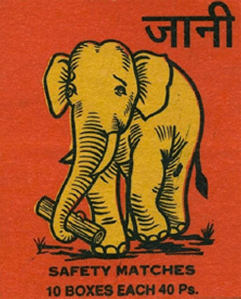
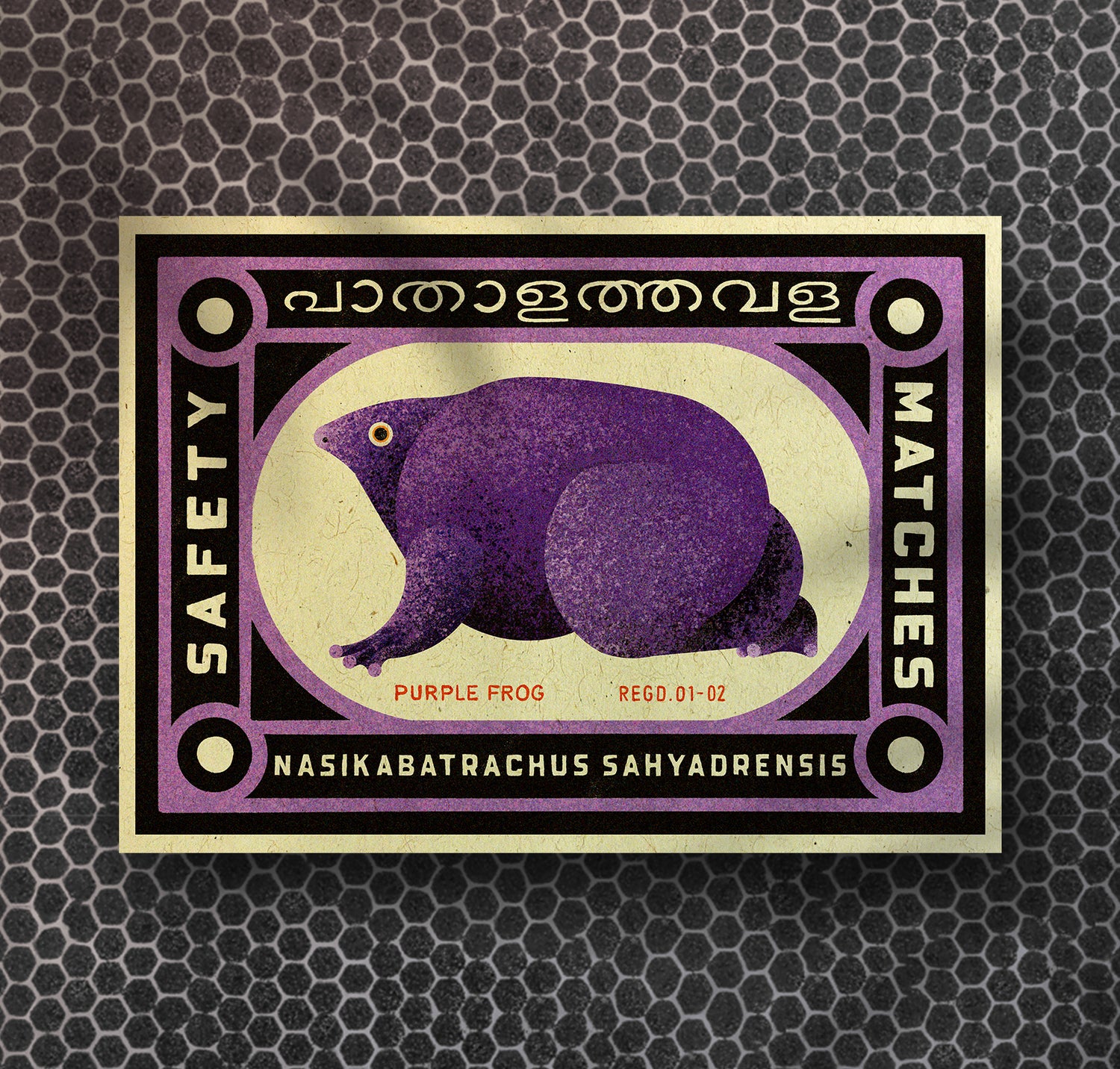
Matchbox 02
Purple Frog
Ancient myths speak of Maha-Bali, a venerable king of the underworld (Patala). The legend of his annual emergence to visit his land-dwelling people is still celebrated in Kerala as the festival of Onam.
Emerging only once a year during the monsoon season, this burrowing frog is known locally as പാതാളത്തവള (pātāḷattavaḷa, the underworld one). Despite only being discovered in 2003, it has outlived the dinosaurs. Its closest relative in Seychelles makes it living evidence that India was once a part of Africa.
Endemic to the Western Ghats of India (specifically Kerala and Tamil Nadu), it can be found belowground near the streams of cardamom, coffee and rubber plantations, and evergreen / semi-evergreen forests.
-
SCIENTIFIC NAME
Nasikabatrachus sahyadrensis
-
LOCAL NAME
പാതാളത്തവള
pātāḷattavaḷa
[Malayalam]
-
STATUS (2022)
[EN ↓] Endangered;
declining population -
LOCATION
India
-
REFERENCE MATCHBOX
Lock Safety Match
Image by Patricia M, courtesy of Flickr
-

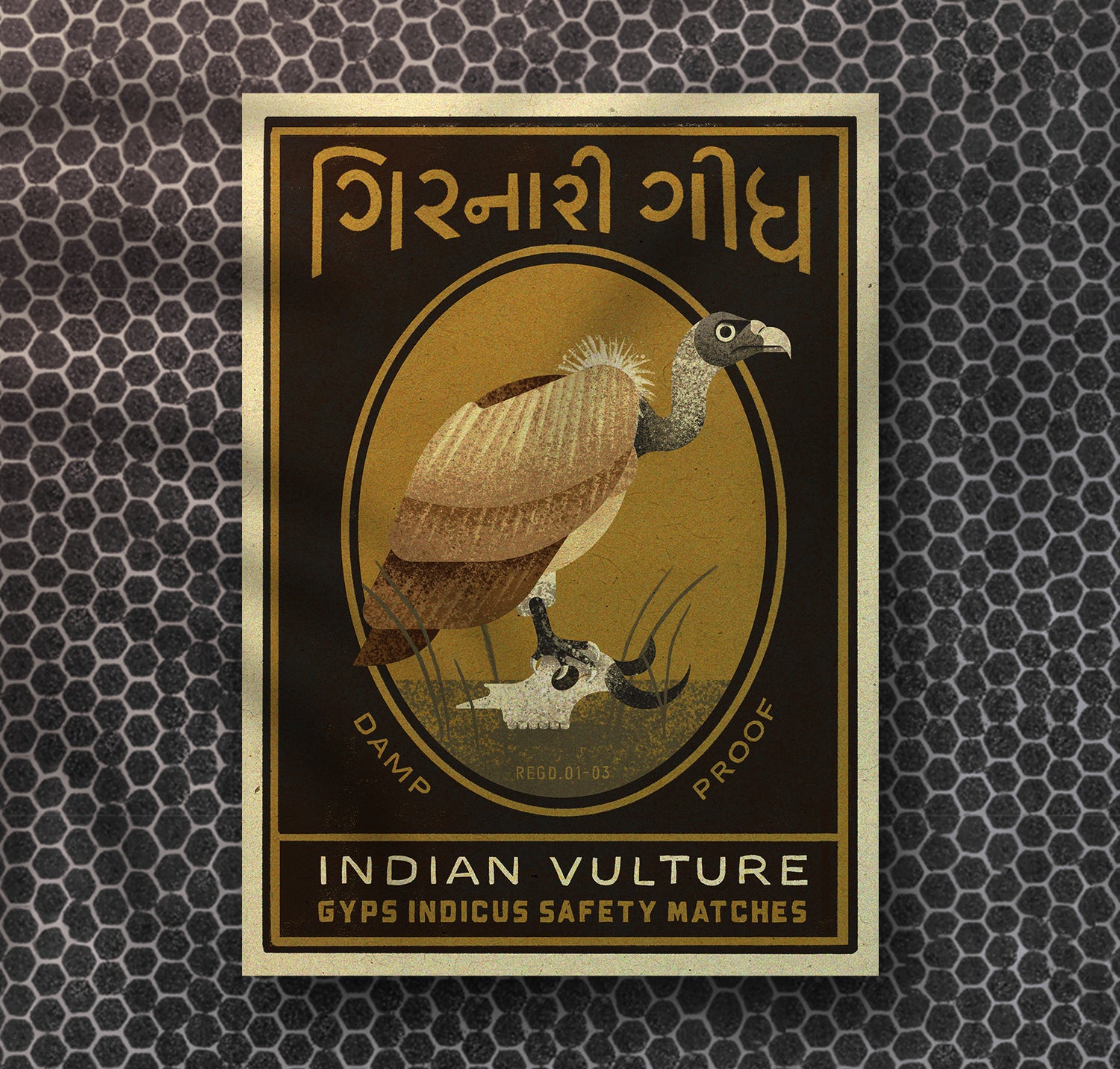
Matchbox 03
Indian Vulture
Rising dramatically from the flat plains of Gujarat is an ancient mountain that predates the Himalayas. Mount Girnar is the home of ancient dynasty rock inscriptions, a sacred site for Buddhists, Hindus and Jains, and a nesting ground for the fastest declining species in the world.
Known in Gujarat as Girnari Gidh, the Indian vulture shifted from being a common bird across the Indian subcontinent to critically endangered in only three decades. The Indian Vulture is mainly found in forests, grasslands and shrublands, and observed near human-occupied spaces across India and parts of Pakistan.
-
SCIENTIFIC NAME
Gyps indicus
-
LOCAL NAME
ગિરનારી ગીધ
Girnari Gidh
[Gujarati]
-
STATUS (2022)
[CR ↓] Critically Endangered; declining population
-
LOCATION
India; Pakistan
-
REFERENCE MATCHBOX
Lionhead
Image by Patricia M, courtesy of Flickr
-
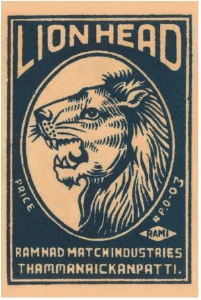
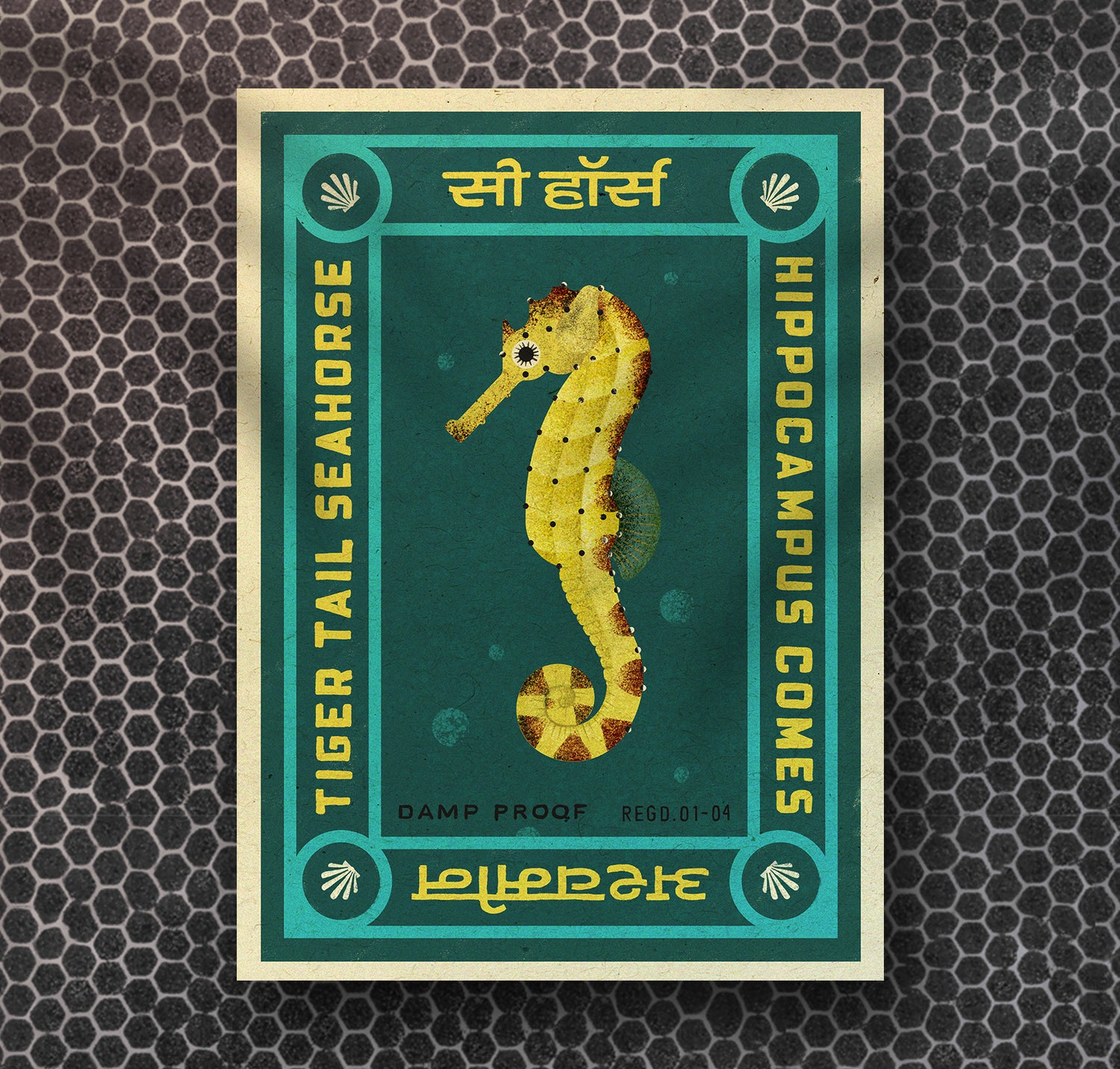
Matchbox 04
Tiger Tail Seahorse
The tiger tail seahorse, named for its striped tail, inhabits the coastlines of Southeast Asian countries and the Andaman Islands of India. It is a wonder of nature - a monogamous horse-headed fish known for its child-bearing males.
In Asia, its association with sea dragons makes it a symbol of luck and power; its armour-like exoskeleton that protects its delicate organs makes it a symbol of protection. Some believe that one’s health and internal organs can be protected by consuming seahorses, others believe wearing or carrying dried seahorses can serve as an amulet of protection or luck.
In an attempt to harness these powers, it has become one of the most commonly traded species of seahorse in the traditional medicine and aquarium trade.
-
SCIENTIFIC NAME
Hippocampus comes
-
LOCAL NAME
अश्वमीन
aśvamīna
[Hindi]
-
STATUS (2022)
[VU ↓] Vulnerable; declining population
-
LOCATION
India; Indonesia; Malaysia; Philippines; Singapore; Thailand; Vietnam
-
REFERENCE MATCHBOX
Shell Safety Matches
Image by Patricia M, courtesy of Flickr
-

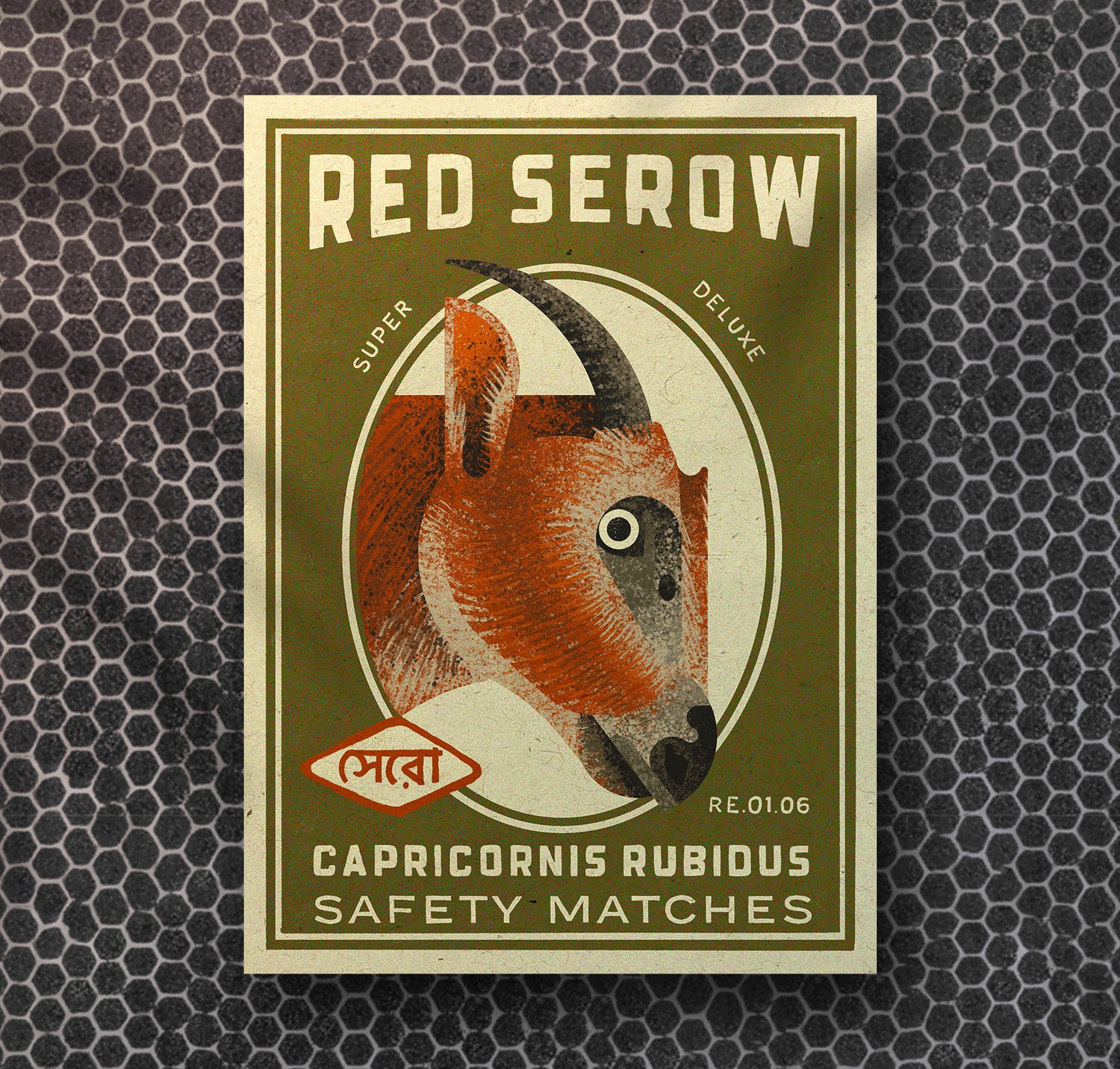
Matchbox 05
Red Serow
Little is known about the natural history of the red serow. With goat-like bodies and long donkey-like ears, it is described as a goat-antelope. Of all serows, the red serow is believed to be closest to its ancestor, a serow-like animal that lived between two and seven million years ago.
The name ‘serow’ comes from the Lepcha word ‘saro’ (pronounced suh-ROH) referencing a long-haired Tibetan goat. Considered to be an aboriginal language that pre-dates Tibetan languages, Lepcha is still spoken in Sikkim, West Bengal, Nepal and Bhutan.
Agile on rocky terrain, the red serow can be found in the hilly tropical forests and thickly forested gorges and valleys of Myanmar, eastern India, and China.
-
SCIENTIFIC NAME
Capricornis rubidus
-
LOCAL NAME
লাল সেরো
Lal serow
[Bengali]
-
STATUS (2022)
[VU ↓] Vulnerable; declining population
-
LOCATION
China; India; Myanmar
-
REFERENCE MATCHBOX
Goathead Safety Matches
Image by Patricia M, courtesy of Flickr
-
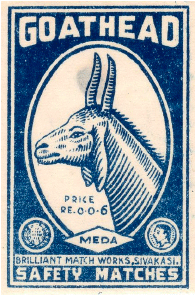

Matchbox 06
Peacock Tarantula
The tree-dwelling spiders native to India and Sri Lanka are defined by their exceptional ability to hide. Tucked in silken retreats beneath rocks or in the hollows of ancient trees, they have discretely coexisted with locals, remaining unknown to the rest of the world.
Covered in metallic blue hairs with patches of intense saffron and bands of black and white, the peacock tarantula has an impressive track record of remaining hidden despite its striking iridescent appearance. It remains so well hidden that 102 years passed between its first two recorded sightings.
Traversing forests with ladders and dental mirrors, researchers have only found this species in a single, highly fragmented location: a degraded and dry deciduous reserve forest in Andra Pradesh.
-
SCIENTIFIC NAME
Poecilotheria metallica
-
LOCAL NAME
ٹرنٹولا
Tarantula
[Urdu]
-
STATUS (2022)
[CR ↓] Critically Endangered; declining population
-
LOCATION
India
-
REFERENCE MATCHBOX
Spider Safety Matches
Image by Patricia M, courtesy of Flickr
-

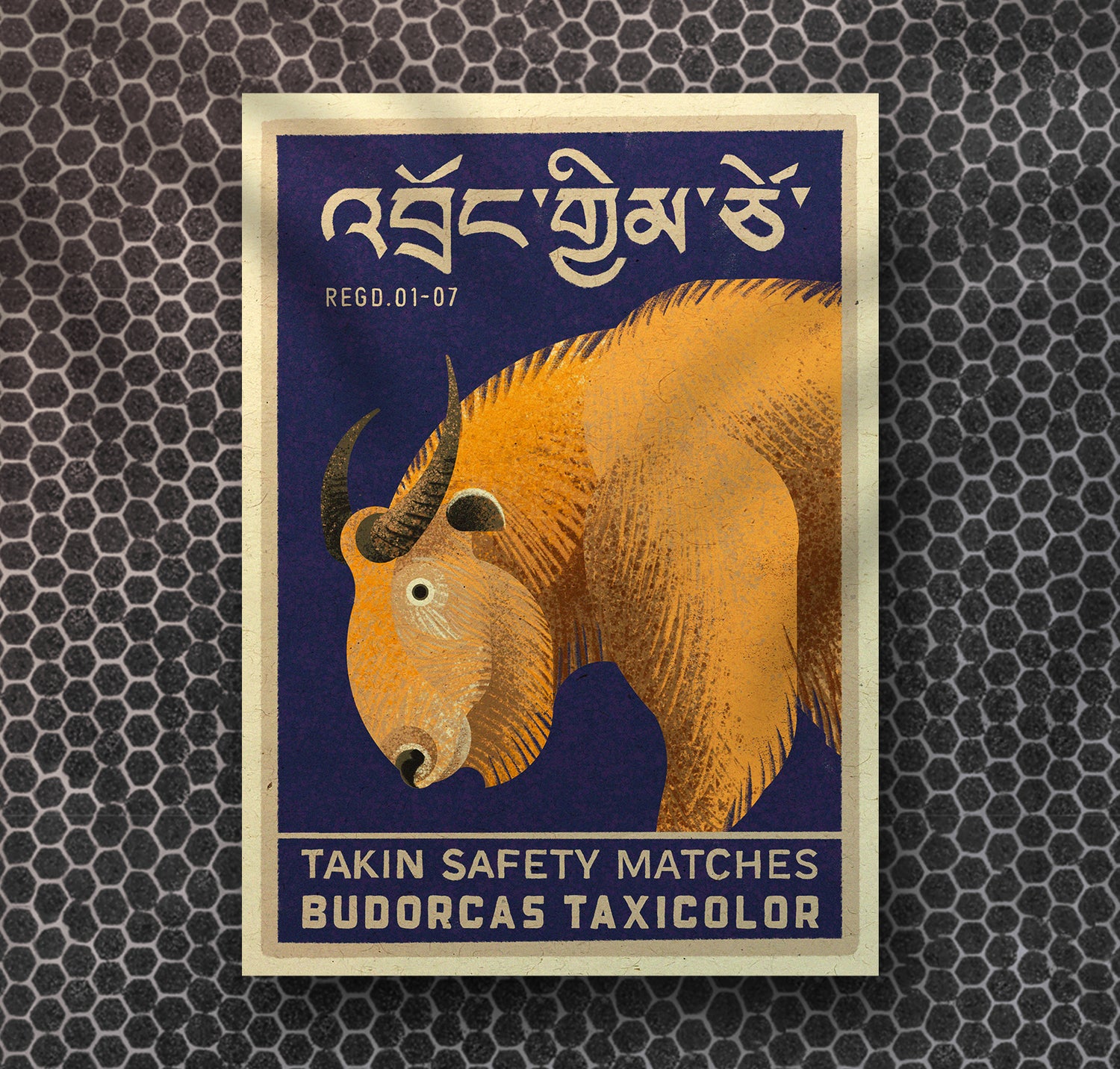
Matchbox 07
Takin
In Bhutan, the takin is a living mythical beast. A 15th-century legend attributes its creation to a Tibetan saint, Drukpa Kunley. Known for his eccentricity, the saint performed a miracle after a feast combining the bones of a goat and cow to create a new animal called “Dong Gyem Tsey,” the takin.
Declared the national animal of Bhutan for its association with local religion and mythology, the takin is honoured and protected. Likewise, vast areas of Bhutan have been protected as sacred landscapes for centuries.
The takin is native to Bhutan, China, northeast India, and northern Myanmar and can be found on steep slopes in pine shrubs, alpine meadows and subtropical forests.
-
SCIENTIFIC NAME
Budorcas taxicolor
-
LOCAL NAME
Dronggimtsi
[Dzongkha]
-
STATUS (2022)
[VU ↓] Vulnerable; declining population
-
LOCATION
Bhutan; China; India; Myanmar
-
REFERENCE MATCHBOX
Raja Parrot
Image by Patricia M, courtesy of Flickr
-


Matchbox 08
Red Panda
Far beyond its quiet life in the mountains, the red panda has become an exotic celebrity with its soft features. Its cinnamon red fur and soft undercoat provide warmth from the mountain chill, and its long, bushy tail acts as a wraparound blanket (and helps with maintaining balance.)
Despite living in pockets of the cool and rainy mountain forests of Nepal, India, Bhutan, northern Myanmar (Burma), and central China, 5 million-year-old fossils of ancient red pandas have even been found in North America.
The origin of the name panda comes from the Nepali term ‘nigalva ponva’ which translates to bamboo-eater; 95% of the red panda's diet is bamboo. The Sherpas living in Nepal and Sikkim still use this name today.
-
SCIENTIFIC NAME
Ailurus fulgens
-
LOCAL NAME
निगल्वा पोंवा
Nigalva Ponva
[Nepali]
-
STATUS (2022)
[EN ↓] Endangered;
declining population -
LOCATION
Bhutan; China; India; Myanmar; Nepal
-
REFERENCE MATCHBOX
The Girl Safety Matches
Image by Patricia M, courtesy of Flickr
-
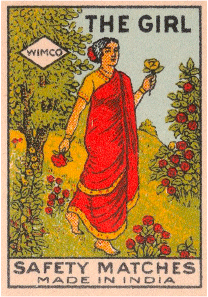
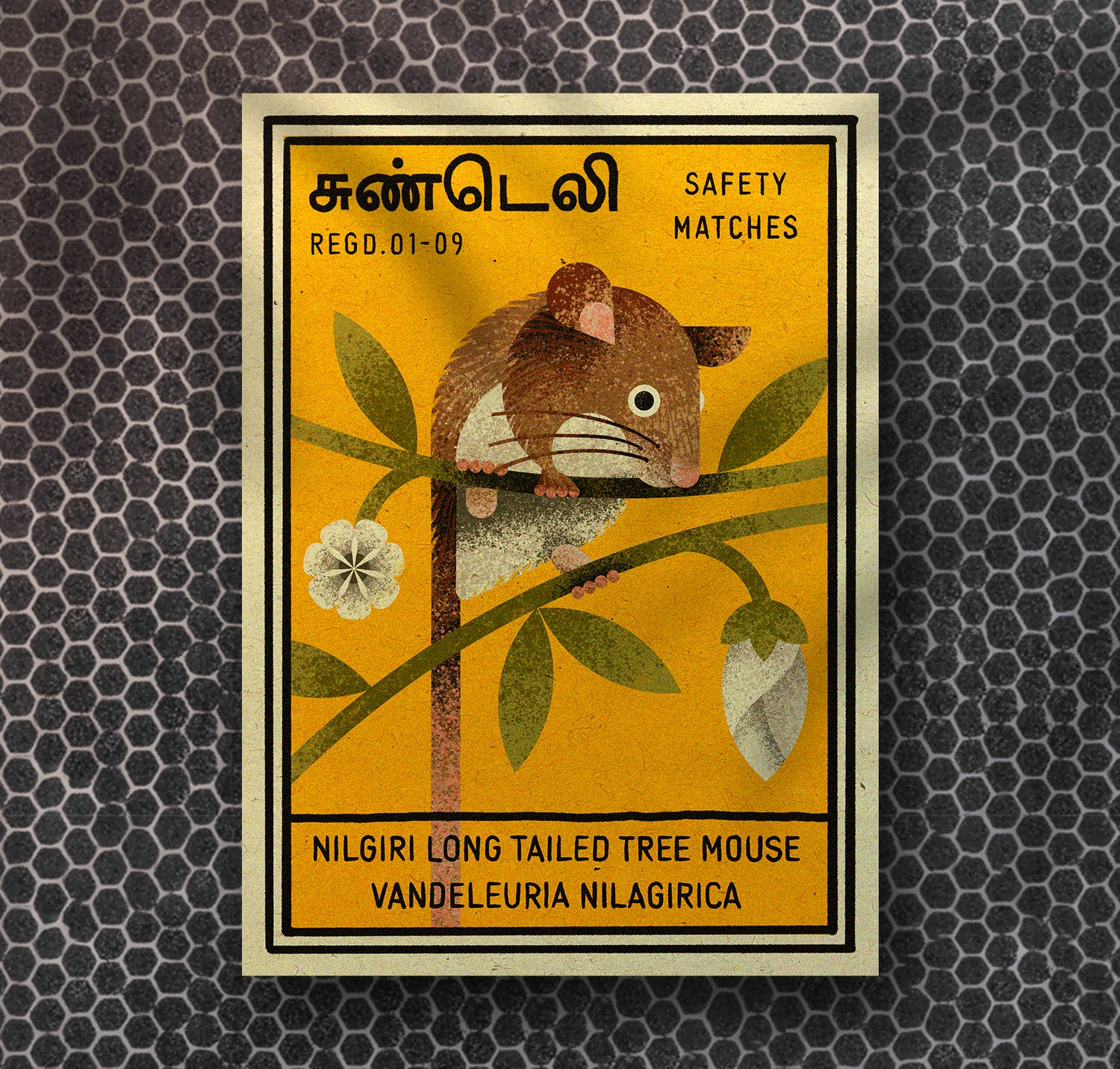
Matchbox 09
Nilgiri Mouse
Along the western coast of India rise the Western Ghats, a mountain range older than the Himalayas. Part of this range is named Nilgiri (நீலகிரி) or ‘Blue Mountains.’ Every twelve years, the Neelakurinji flower that once covered these hills would bloom, carpeting with mountains with blue. The Paliyan, a nomadic hunter-gatherer tribe of the Western Ghats reference the blossom to track their age.
Within the tropical Nilgiri forests lives the small and shy Nilgiri long tailed tree mouse. It builds spherical nests made of grass and leaves in forests and undisturbed plantations of coffee, banana and cardamom. Most active at night, it nibbles on spruce leaves, small insects, flowers and buds.
-
SCIENTIFIC NAME
Vandeleuria nilagirica
-
LOCAL NAME
சுண்டெலி
Cuṇṭeli
[Tamil]
-
STATUS (2022)
[EN ↓] Endangered;
declining population -
LOCATION
India
-
REFERENCE MATCHBOX
Lal Fool
Image by Patricia M, courtesy of Flickr
-
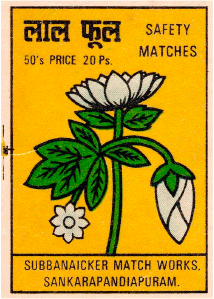
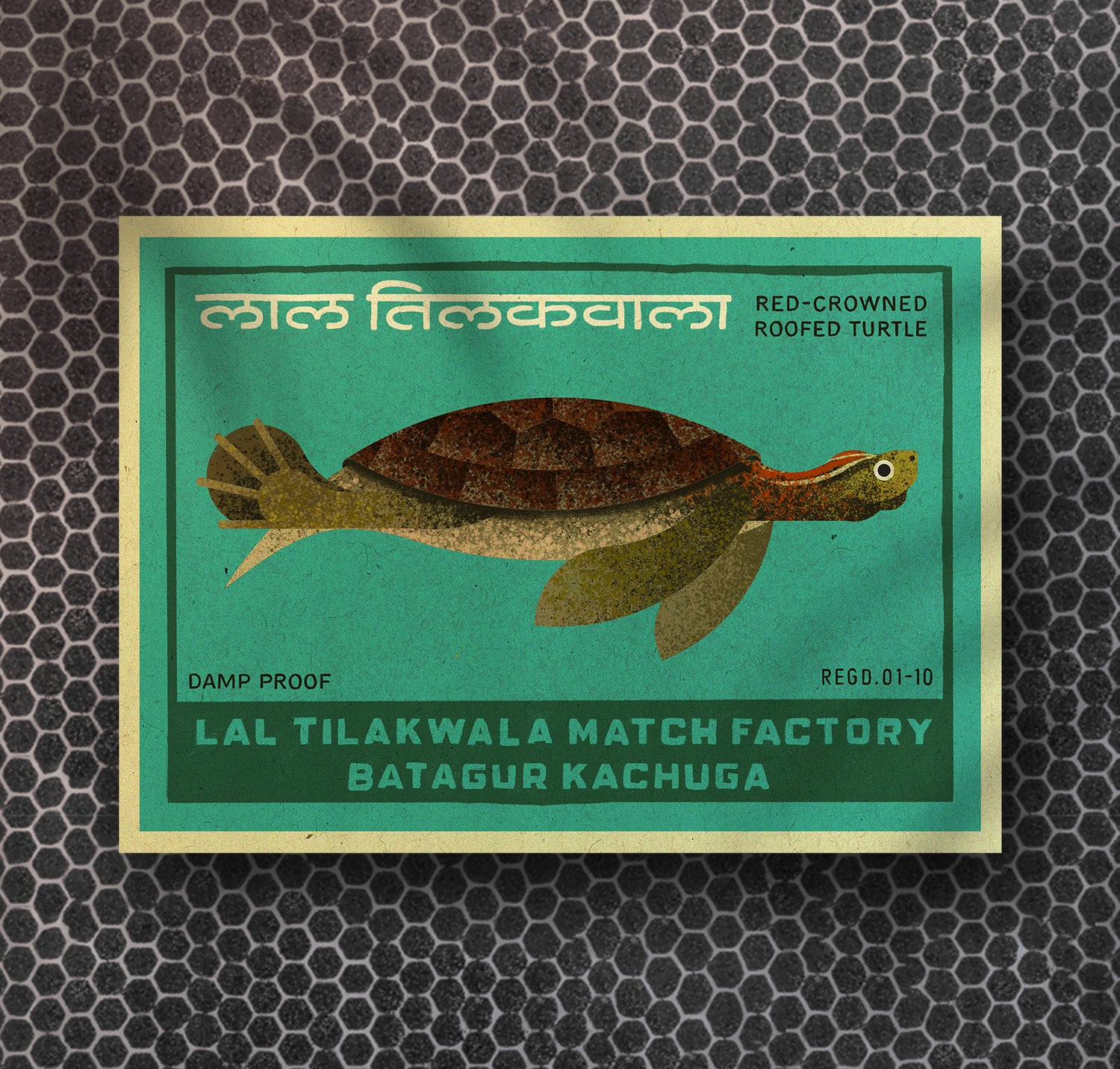
Matchbox 10
Red-crowned Roofed Turtle
Named for its streaks of red along its head, the red-crowned roofed turtle has an endearing Hindi name, Lal Tilakwala. लाल ‘Lal’ means red, and तिलक ‘tilak’ is a mark usually worn on the forehead; it can be applied as a symbol of enlightenment or respect, or as a means to honour something. वाला ‘Wala’ is a suffix that can indicate what a person wears.
During the breeding season, the male turtles flaunt their ‘tilaks’ of red, yellow and blue along their heads and necks. These freshwater turtles are restricted to the large swift-flowing tributaries of the Ganges, a sacred river to Hindus and a lifeline to the species (including millions of people) who rely on it for survival.
-
SCIENTIFIC NAME
Batagur kachuga
-
LOCAL NAME
लाल तिलकवाला
Lal tilakwala
[Hindi]
-
STATUS (2022)
[CR ↓] Critically Endangered; declining population
-
LOCATION
India
-
REFERENCE MATCHBOX
Ainak
Image by Patricia M, courtesy of Flickr
-

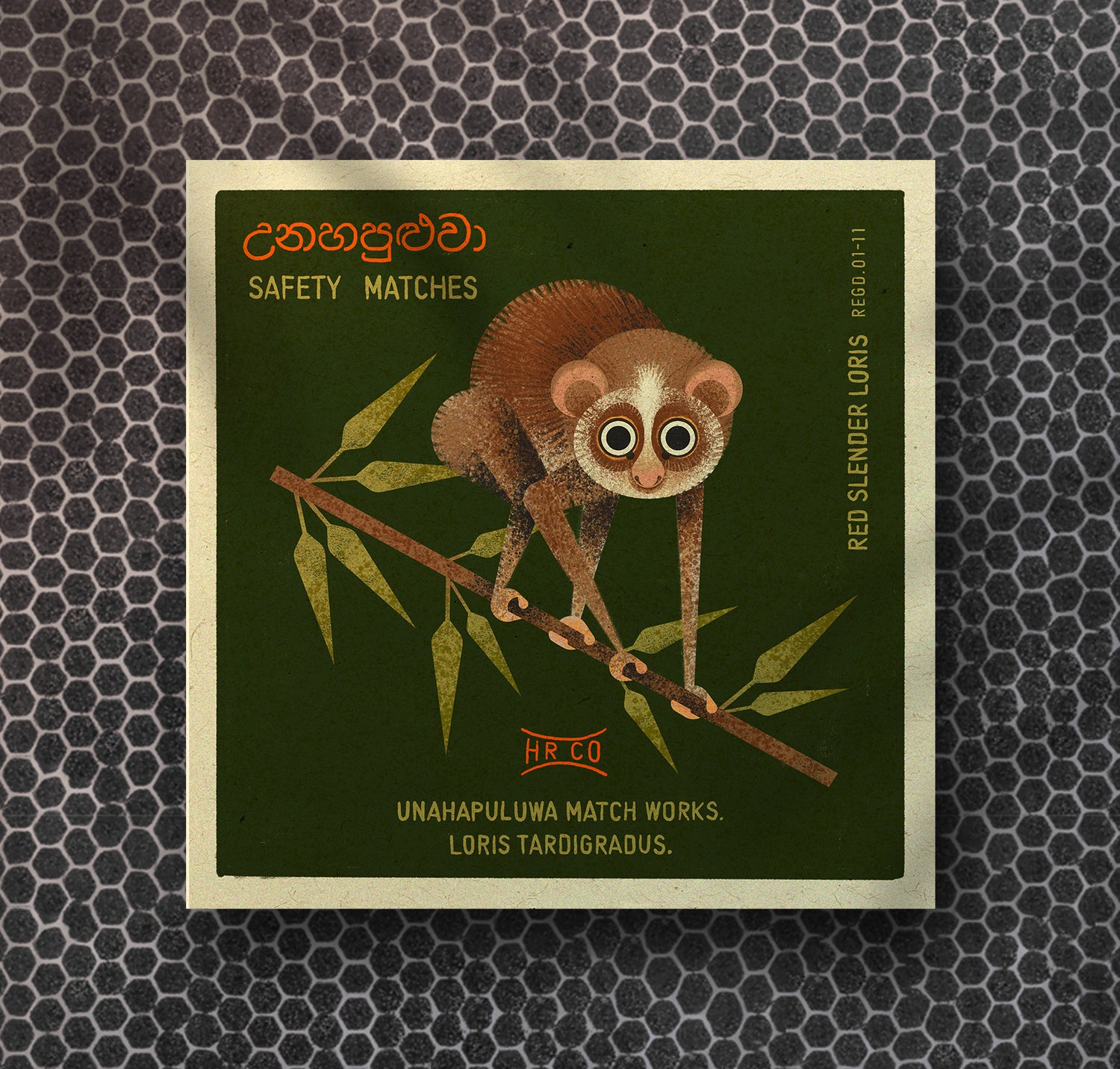
Matchbox 11
Red Slender Loris
Endemic to the rainforests of Sri Lanka, the small, wide-eyed, red slender loris has a misleadingly sweet and cuddly appeal.
This loris is known to have very sharp teeth and to bite savagely. As one of the most social nocturnal primates it spends its night grooming, play-wrestling with others in its group, or hunting alone for animal prey (relishing lizards and geckos the most).
By day, the group sleeps together in tangled branches or curled up with their heads tucked between their legs. They hang upside down to breed, and are only willing to mate if a suitable branch is found.
-
SCIENTIFIC NAME
Loris tardigradus
-
LOCAL NAME
උනහපුළුවා
Unahapuluwa
[Sinhala]
-
STATUS (2022)
[EN ↓] Endangered;
declining population -
LOCATION
Sri Lanka
-
REFERENCE MATCHBOX
Sun Bird Safety Matches
Image by Patricia M, courtesy of Flickr
-
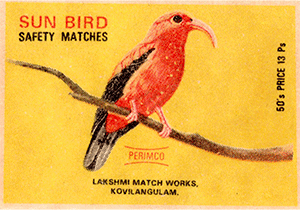

Matchbox 12
Tiger
Feared and revered, the tiger has spellbound humankind across millennia, weaving into the mythology, philosophy and shrines of cultures far and wide. Tigers once prowled as far west as Turkey, as south as Bali, and as far north and east as Russia. The tiger was depicted in Neolithic art, impressed in the seals of the Indus Valley civilization and Chola dynasty, and is the national animal of India, Bangladesh, Malaysia and South Korea.
As the largest living cat species remaining, the tiger has maintained its status as an enigmatic cultural icon. However, being a charismatic megafauna is a double-edged sword; the symbolic value and popularity of wild tigers create support for environmentalist goals, whilst their power and rarity continue to attract poachers.
-
SCIENTIFIC NAME
Panthera tigris
-
LOCAL NAME
बाघ
Baagh
[Hindi]
-
STATUS (2022)
[EN ↓] Endangered;
declining population -
LOCATION
Bangladesh; Bhutan; China; India; Indonesia; Malaysia; Myanmar; Nepal; Russia; Thailand
-
REFERENCE MATCHBOX
Fool
Image by Patricia M, courtesy of Flickr
-













